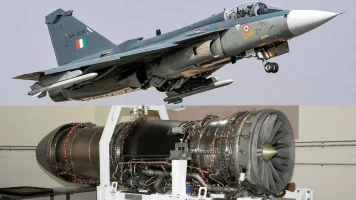- Views: 2K
- Replies: 10
Hindustan Aeronautics Limited (HAL) remains committed to making its domestically developed Hindustan Turbo Fan Engine (HTFE-25) ready for production by 2030, despite recent reports highlighting significant delays in the programme, according to company officials.
The project is seen as vital for India's goal of self-reliance in aerospace propulsion technology.
The HTFE-25 is a 25 kilonewton (kN) thrust turbofan engine intended to power a variety of aircraft, including trainer jets, unmanned aerial vehicles (UAVs), and potentially light combat or regional jets.
Development began in 2013 under HAL's Aero Engine Research and Development Centre (AERDC) in Bengaluru, with the engine's core successfully running for the first time in 2015.
This engine is designed as a low-bypass, twin-spool turbofan featuring advanced components like a three-stage low-pressure compressor and a five-stage high-pressure counterpart, along with air-cooled turbine blades.
HAL estimates a potential market demand of 200-250 units for applications ranging from trainers to business jets, underscoring its importance to India's indigenous aerospace ambitions.
Early development saw notable progress. Following the inaugural core run witnessed by the then-Defence Minister Manohar Parrikar in 2015, HAL produced two core engines by 2019.
These underwent 339 test runs, achieving milestones such as cold starts and reaching full operational speed. Development of an afterburner version also commenced, alongside successful high-altitude trials in Leh.
However, the programme has faced considerable challenges over the last decade. A recent report detailed setbacks stemming from delayed land clearances for essential test beds, unforeseen procurement needs, and existing technology gaps. These issues significantly slowed progress, raising concerns about meeting the original timelines.
Specifically, delays in constructing test facilities hampered the critical Stage II development phase, which involves prototype creation, extensive testing, and certification.
The report also noted unplanned procurement activities, echoing a 2023 Comptroller and Auditor General (CAG) report that criticised HAL for inadequate risk assessment, feasibility studies, and planning, leading to significant financial wastage estimated at nearly Rs 160 crore.
Responding to the recent report, a HAL official acknowledged the slowdown but highlighted corrective measures.
A major step forward was the inauguration of a new, state-of-the-art 10,000 square meter design and test facility at AERDC in December 2023. This centre features advanced computational tools, internal fabrication capabilities, and dedicated dual test beds for the HTFE-25, allowing testing efforts to accelerate.
By mid-2024, acceleration trials had reached 55% engine speed, and the full technology demonstrator engine completed its first successful run.
With these enhanced capabilities, the HAL official expressed confidence that the programme will regain momentum. The focus remains on completing the rigorous Stage II testing and certification processes, with the majority of final tests planned for the coming years.
HAL maintains the projection that the engine will achieve production readiness by 2030, acknowledging the typical five-year-plus timeframe required to transition from a technology demonstrator to a fully certified engine.
Once certified, the HTFE-25 could power platforms like the HAL Hawk-I trainer, the basic trainer HTT-40, and various unmanned systems. There is also potential for integration into future projects like the Combat Air Teaming System (CATS) or a next-generation trainer. An afterburner variant, potentially generating up to 40 kN thrust, is also being considered for light fighter aircraft or advanced UAVs.
The successful development of the HTFE-25 is strategically crucial for India. It promises to reduce the nation's dependence on foreign engine suppliers, a vulnerability that has impacted programmes like the Tejas Light Combat Aircraft.
Achieving self-sufficiency in this critical area would bolster India's defence capabilities, support the government's 'Aatmanirbhar Bharat' initiative, and enhance its standing in the global aerospace market.
However, meeting the 2030 target hinges on successfully navigating the remaining technical and procedural challenges.




